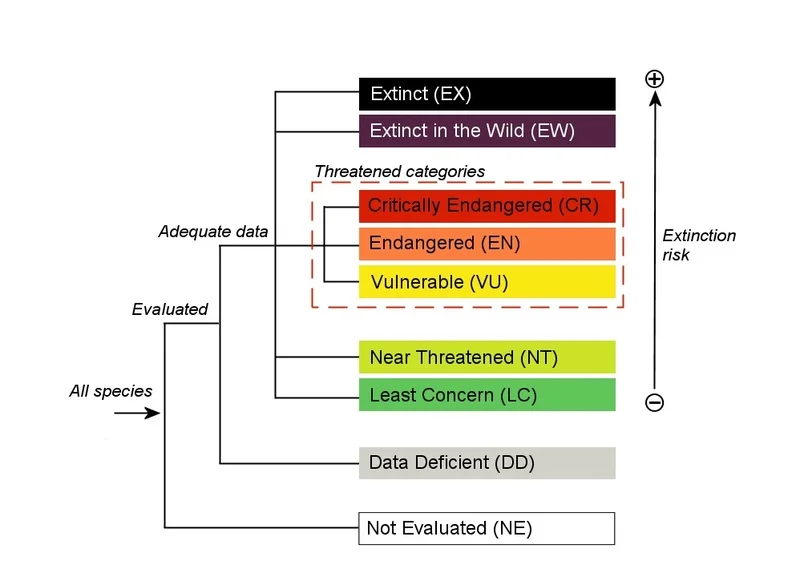Important Facts For Prelims
National ‘Red List’ Assessment Initiative
- 14 Oct 2025
- 6 min read
Why in News?
India launched the five-year National Red List Assessment Initiative (2025-2030) to evaluate the conservation status of its flora and fauna, announced at the IUCN World Conservation Congress in Abu Dhabi.
What is the National ‘Red List’ Assessment Initiative?
- About: It aims to systematically identify and protect India’s most vulnerable species, in line with global environmental commitments, and IUCN standards.
- It will evaluate the extinction risk of approximately 11,000 species—including 7,000 flora and 4,000 fauna—to develop a National Red List.
- Implementing Bodies: It will be spearheaded by the Union Ministry of Environment, Forest and Climate Change, with key implementing bodies including the Botanical Survey of India (BSI), Zoological Survey of India (ZSI), and the Wildlife Institute of India (WII).
- Global Biodiversity Commitments: It will fulfill Target 4 of the Kunming-Montreal Global Biodiversity Framework (KM-GBF), which calls for halting species extinction, protecting genetic diversity, and managing human-wildlife conflicts.
- As a signatory to the Convention of Biological Diversity (CBD), India is obligated to monitor and conserve its biodiversity, and this assessment provides the essential scientific basis for that effort.
- India's Species Endemism & Status: Of the assessed fauna, 13.4% are threatened, 289 species are near threatened, and 13.8% are data deficient, with their conservation status unknown.
- India exhibits high endemism, with 79% of amphibians and 54.9% of reptiles found nowhere else in the wild.
International Union for Conservation of Nature (IUCN)
- About: The IUCN is a membership union uniquely comprising both government and civil society organizations.
- Since its creation in 1948, IUCN has evolved into the world’s largest and most diverse environmental network.
- Role: Headquartered in Gland, Switzerland, it serves as the global authority on the status of the natural world and the actions needed to protect it.
- Red List: The IUCN oversees the Red List of Threatened Species, the most comprehensive global inventory of the conservation status of plants and animals.
- The Red List Categories reflect a species’ risk of extinction. The nine categories are outlined below:
- IUCN World Conservation Congress: The IUCN World Conservation Congress, often called the Olympics of Conservation, is the world’s largest and most important conservation event.
- It is held once every four years, with the 2025 edition being held in Abu Dhabi, United Arab Emirates.
- It aims to conserve the environment, address global sustainability challenges, and improve natural resource management for human, social, and economic development.
Frequently Asked Questions (FAQs)
1. What is the IUCN Red Data List?
The IUCN Red List is a global database maintained by the International Union for Conservation of Nature (IUCN) that assesses the conservation status of species.
2. What is the objective of India’s National Red List Assessment Initiative?
To evaluate the extinction risk of 11,000 species and develop a National Red List, supporting biodiversity conservation aligned with IUCN standards.
3. Which bodies are implementing the National Red List Assessment in India?
The Union Ministry of Environment, Forest and Climate Change, in collaboration with BSI, ZSI, and WII, leads the assessment.
4. What percentage of India’s species has been globally assessed by the IUCN so far?
Only 7.2% of fauna and 6.33% of plants (including algae, fungi, and microbes) have been assessed, highlighting significant data gaps.
UPSC Civil Services Examination, Previous Year Question (PYQ)
Q. Consider the following pairs (2019)
Wildlife : Naturally found in
- Blue-finned Mahseer : Cauvery River
- Irrawaddy Dolphin : Chambal River
- Rusty-spotted Cat : Eastern Ghats
Which of the pairs given above are correctly matched?
(a) 1 and 2 only
(b) 2 and 3 only
(c) 1 and 3 only
(d) 1, 2 and 3
Ans: (c)
Q. Which one of the following is not a site for in-situ method of conservation of flora? (2011)
(a) Biosphere Reserve
(b) Botanical Garden
(c) National Park
(d) Wildlife Sanctuary
Ans: (b)







